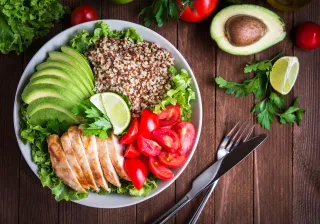Collaboration in research helped maltster launch new proteinaceous plant-based ingredient. Interest in new legume-based raw materials and in sprouting legumes led to cooperation between the Finnish family enterprise Viking Malt and VTT. The result was a new proteinaceous plant-based raw material for the needs of the food industry.
Text: Tarja Rannisto
Photos: Viking Malt
Viking Malt, the world's ninth largest producer of malt, had long been interested in expanding its business model and wanted a conspicuous role in introducing new products.
“People are increasingly health-conscious, which is reflected in consumption patterns. Consequently, beer consumption is fairly even, and the proportion of non-alcoholic beer is growing”, explains Annika Wilhelmson, director of quality and CSR at Viking Malt.
It became evident at Viking Malt that plant-based protein sources are a rapidly growing market. Thinking emerged in the company how their skills and knowledge could be applied to the field of plant-based protein, and soon there was a rush to look for new raw materials for sprouting.
“Meat is known to cause more greenhouse gas emissions than plant-based food, which is why people are shifting towards more plant-based nutrition. We were thinking if we might come up with something related to that and make use of our core skills and knowledge – sprouting – also with legumes” Wilhelmson says.
Multisectoral skills and knowledge for a development project
Viking Malt understood what kind of process had to be developed for legumes, and how a new and good product could be launched. However, the company had insufficient resources for studying the applications on its own, as its research and development department is small.
Viking Malt was also aware of VTT's robust experience in the development of plant-based products and of its skills related to understanding their food applicability. Therefore, the research partner was asked to help speed up the project.
VTT joined the project that required the skills and knowledge of about 20 people from different sectors. The collaboration brought the expertise and experience that the project needed in the processing of the plant-based raw material, as well as analytics and equipment to ensure the quality of the products.
“Research, development, and understanding the use of plant-based raw materials in the production of foods are among the main focal points of our research. We enthusiastically took up the task of helping Viking Malt develop the process and understanding the characteristics of new ingredients”, says researcher Pia Silventoinen, the project manager of the research project at VTT.
“At the beginning of the project it was naturally important to understand the customer’s hopes for the project, for example, in which areas VTT’s skills and knowledge can be most useful and the time required for the development work”, Silventoinen says.
New proteinaceous plant-based raw materials
A VTT research group analysed changes in the composition of a bean, and in the sensory, technological, and nutritional quality. Silventoinen says that VTT also enhanced the customer's understanding of the applicability of the product in different types of food products.
In the process, a dormant bean is activated by germination, eliminating substances that cause bloating and flatulence in some people when they eat the beans. During germination, the bean uses the substances itself, replacing them with sugar. This softens the taste.
“We have developed a way to dry a bean to make the taste considerably less ‘bean-like’, and more suitable for use in yoghurts, for example. The bitter taste also goes away, and it is replaced by a mild and fresh grainy taste”, Wilhelmson explains, praising the value of VTT's high level of skills in the analysis of taste modification.
“We tailored methods that enabled us to evaluate how the processing would affect the taste. I did not know that sensory evaluation could be used for things of such significance”, she says.
VTT also made a preliminary microbiological risk evaluation. Viking Malt found this to be very useful in thinking about the possible risks of the new raw material, such as the harmful microbes that the bean might carry.
Developing foodstuffs is useless if the end result is a bad-tasting product.
Research target: suitability of sprouted products in different food models
Wilhelmson says that VTT helped its partner understand how germination affects the nutritional quality and the technological functionality of the raw material.
“For example, the solubility of the proteins in the raw material has a significant effect on how well it functions in various final food products. Consequently, studying solubility and testing the raw materials in food models gave important information on the most suitable applications”, Silventoinen explains.
Research helped in quickly mapping the applicability of the bean to for example plant-based yoghurt and meat alternatives.
Like a bean that is activated in germination, Viking Malt also wants to awaken the food industry and consumers to the fact that raw material choices affect the future of our planet.
“By developing new applications for legumes, we promote natural diversity and sustainable development. Legumes are suited for that purpose, as they bind nitrogen from the air and improve the microbiome of the soil”, Wilhelmson observes.
In addition, germination also modifies taste and nutritional value of the product/ingredient through a natural process. As a healthy and tasty raw material with many possible applications, germinated beans are expected to be of interest to consumers.
The project started in the spring of 2019. Development work progressed quickly with the help of VTT's expertise and testing, and the ready product was launched in the autumn of 2020.
“We observed then that the product prototype is ready and that there is demand for it. We did not want to wait any longer, as we wanted to utilise all possibilities on the market”, says Wilhelmson, describing the project.
“It is great to be involved in a project in which sustainability and the environmental angle have been taken into account”, she concludes.







